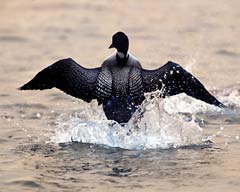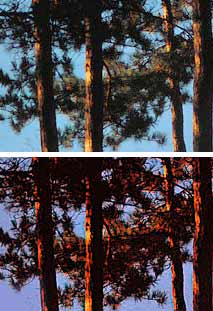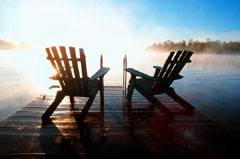Photoshop and PSP Channels pg 5: Production Graphics with Wendy Peck at webreference.com
 |
Photoshop and PSP Channels: Enhance Images and Create Special Effects | |
|
This image is a color channel reverse for the image shown on page 4. See a larger sample of both images. I love this effect - could so easily have been taken late in the evening instead of in the sun. |
You now know how to split channels apart and merge the pieces back together. Plus, you understand how to view channel changes in the main screen (Photoshop only). But what can you do with it? There are two main areas where channels can carry a heavy load: enhancing images and special effects. Let's take a look at just a few little techniques to get your mind going in the right direction. Perhaps the best idea would be to think in tiny amounts. If you are working on an enhancement and everything you do is too heavy handed, think channels. For special effects, your assignment is just to play. Tough job, but someone has to do it and it is the best way to understand what you can do with channels and effects. |
|
|
Over sharpening a color channel will adjust the color in your image. The green channel in the lower image was sharpened severely.
The lower corner of this image contained many artifacts from earlier compression. Selecting the offending pixels on the red channel, and filling with a solid color, helped a lot. See the image above this one for the result. Photos © Tom Thomson Photography. |
Image enhancement Check back to page 4 and see the subtle enhancement I did to an image to pull out a little more detail in a tree. By sharpening only the green channel, the needles popped out just a bit, and over the entire image, really improved it. However, be careful with what you do. This poor image has been worked a little hard, but I wanted to show you what happens when you have a heavy hand with channels work. When you sharpen a full image, color is really not in play other than to sharpen the detail in your image. However, when you are sharpening a channel, you are affecting only one color in the image. Over sharpen the RGB image and you will get ghosting around your detail. Over sharpening a channel and your ghosts will gain color ... quickly. In the image at the left, the lower image has had the green channel drastically over sharpened. As the green in the channel reduces or increases from the sharpening, the red is affected (green and red are inversely related in an image - increase one, the other goes down). You must be very careful with manipulating a channel. Chant 'subtle, subtle, subtle' as you apply filters or adjustments to a channel. Things to keep in mind for enhancing images are sharpening, removing (or adding) noise and sometimes a subtle (note that word) blur on a channel will work wonders. I have used that when I need to sharpen an image, but one color in the image ghosts when I apply the sharpen to the full image. Soften the offending channel, and try again. Experiment. Take a lousy image and see what you can do with it. If you are having trouble exporting an image to JPG or GIF format, try adding a little noise to the channel that may be banding or doing other bratty things on export. I have included a little sample of a semi-fix I did to the image above the screen shot. That corner was gathering artifacts with a vengeance. I went back to the red channel and selected the corner pixels and feathered the selection. I then used the eyedropper to pick up just one color from the selected area and filled the selection with that color. It was not a miracle cure, but the final image is slightly better than it is in the before sample in the screen shot. |
|
|
One filter for two effects. The first image was created with the Circle filter in Paint Shop Pro. The lower image had the same filter applied to only the green channel. |
Special effects The lower image is the same filter, but applied only to the green channel. Interesting results. In the matter of a few minutes, I had a selection of effects created by applying just one filter to many different channel combinations. I am certainly going to return to this subject at a later date. We spent most of our time here with basic techniques, but I have much more to show you. Watch for the sequel. In the meantime, set aside a little time to practice working with channels to enhance the quality of your photos. Then reward yourself with some time to play with filters in channels. A whole new world awaits you. Have fun. |
|
|
|
Photoshop and PSP Channels Tutorial IndexPhotoshop and PSP Channels: What, When and Why? |
URL: https://www.webreference.com/graphics/column41/
Created: January 21, 2001
Revised: January 21, 2001








 Find a programming school near you
Find a programming school near you